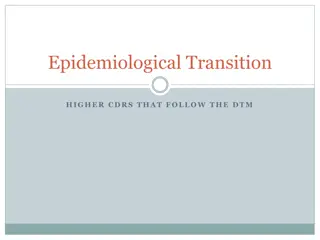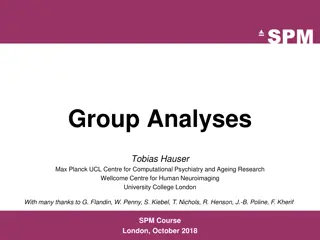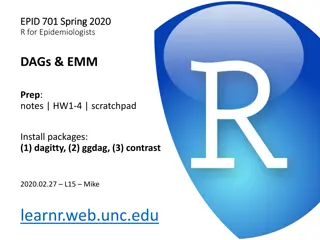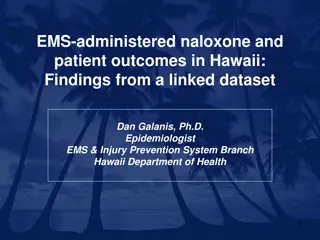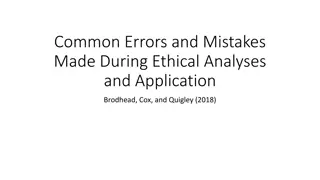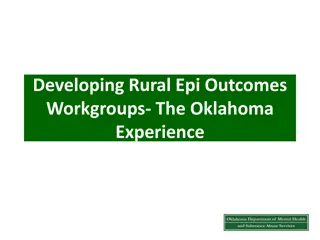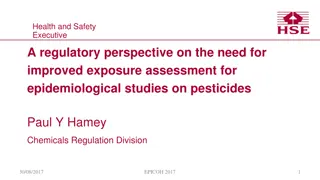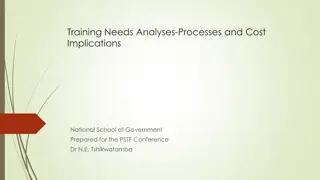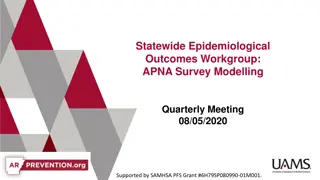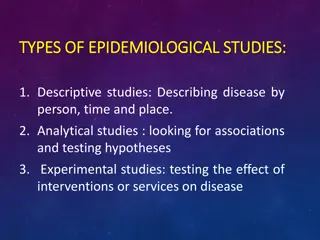Colorado State Epidemiological Profiles - Substance Abuse Trends & Response Task Force
The Colorado State Epidemiological Profiles provide a state-level overview of data from various surveillance sources for prevention, intervention planning, monitoring, and evaluation. The profiles cover demographics, alcohol, marijuana, opioids, sustainability, and next steps. Updated every 2 years,
0 views • 12 slides
The Epidemiological Transition Stages
The Epidemiological Transition model explains shifts in causes of death at different stages of demographic transition. From pestilence and famine to delayed degenerative diseases, each stage highlights key factors influencing mortality patterns. By recognizing these transitions, healthcare professio
1 views • 8 slides
Epidemiological Profiles in Public Health Practice
Epidemiological profiles play a crucial role in substance abuse and mental health planning, helping professionals prioritize issues and raise awareness. The profiles include quantitative and qualitative data to analyze behavioral risk factors, consumption patterns, and clinical outcomes, sourced fro
2 views • 13 slides
FDA Perspective on Epidemiological Cut-off Values (ECVs)
The FDA presents insights on the development and use of Epidemiological Cut-off Values (ECVs) to distinguish wild-type populations from those with acquired resistance mechanisms. ECVs are crucial for determining antimicrobial susceptibility and guiding treatment decisions. The process involves analy
0 views • 13 slides
Epidemiological Study Designs and Measures of Risks
This informative content covers various epidemiological study designs, including observational and experimental studies, clinical trials, cohort studies, and more. It explains the concept of cohorts, indications for cohort studies, and the design considerations involved. Images are included to illus
9 views • 41 slides
Association and Causation in Epidemiological Studies
Exploring the concepts of association and causation in epidemiological studies, this content delves into the complexities of determining if exposure leads to disease risk. It discusses different types of associations, such as spurious, indirect, and direct causal associations, illustrating the chall
5 views • 43 slides
Types of Bias in Epidemiological Studies
Bias in epidemiological studies can arise from misclassification of observations and exposures, leading to incorrect associations between variables. Observation bias, misclassification bias, and non-differential misclassification can impact the accuracy of study results, either minimizing difference
1 views • 11 slides
Neuroimaging Group Analyses: Methods and Results Overview
In this collection of images and descriptions, various aspects of group analyses in neuroimaging research are explored, including statistical parametric mapping, first-level analyses, and assessing different subjects using fixed effects, random effects, and mixed effects analysis. The content delves
4 views • 38 slides
Overview of Epidemiological Cutoff Values (ECVs) in Antimicrobial Susceptibility Testing
Epidemiological Cutoff Values (ECVs) are crucial in determining antimicrobial susceptibility by distinguishing wild-type and non-wild-type microbial populations. ECVs are defined based on factors like minimal inhibitory concentration (MIC) and genetic variation, and are determined through specific m
0 views • 16 slides
Inverse Probability Weights in Epidemiological Analyses
In epidemiological analyses, inverse probability weights play a crucial role in addressing issues such as sampling, confounding, missingness, and censoring. By reshaping the data through up-weighting or down-weighting observations based on probabilities, biases can be mitigated effectively. Differen
2 views • 25 slides
Directed Acyclic Graphs (DAGs) for Causal Inference
Directed Acyclic Graphs (DAGs) play a crucial role in documenting causal assumptions and guiding variable selection in epidemiological models. They inform us about causal relationships between variables and help answer complex questions related to causality. DAGs must meet specific requirements like
1 views • 63 slides
Challenges and Perspectives in Subgroup Analyses for Regulatory and HTA Methods
This presentation discusses the importance of subgroup analyses in pharmaceutical development, focusing on perspectives from regulatory agencies, HTA bodies, and the pharmaceutical industry. It highlights the challenges, methods, and recommendations for optimizing subgroup analyses to enhance drug d
1 views • 26 slides
Statewide Epidemiological Outcomes Workgroup Quarterly Meeting Overview
This overview captures the key discussions of the Statewide Epidemiological Outcomes Workgroup Quarterly Meeting. Topics included the NSDUH, Monitoring the Future survey, Youth Risk Behavioral Surveillance Survey, Arkansas Department of Human Services Annual Report, and Crime Information Center data
1 views • 9 slides
Enhancing Pesticide Exposure Assessment for Epidemiological Studies
Focuses on IMPRESS project aiming to improve methodologies for assessing occupational pesticide exposure in epidemiological studies. Reviews challenges in retrospective exposure assessment, proposes methodologies, and presents key project results to date, emphasizing the use of various exposure asse
1 views • 15 slides
EMS-Administered Naloxone and Patient Outcomes in Hawaii: Epidemiological Study
This study presents findings from a linked dataset analyzing EMS-administered naloxone and patient outcomes in Hawaii from 2012-2016. Part 1 covers basic epidemiological descriptions and linkage to hospital billing data, while Part 2 investigates associations between EMS response times and patient o
0 views • 14 slides
Prescription Drug and Opioid Misuse in Illinois Epidemiological Profile
Explore the Illinois Statewide Epidemiological Profile on Prescription Drug and Opioid Misuse, developed by the Illinois Statewide Epidemiological Outcomes Workgroup and funded by Substance Abuse and Mental Health Services Administration. The profile covers consumption, prevalence, contributing fact
1 views • 28 slides
Evidence for Hydrometeor Storage and Advection Effects in DYNAMO Budget Analyses of the MJO
Variational constraint analyses (VCA) were conducted for DYNAMO in two regions to compare observed radar rainfall data with conventional budget method results, examining differences and composite analyses of MJO events. The study utilized input data including Gridded Product Level 4 sounding data an
0 views • 13 slides
Formulation of Research Questions, Objectives, and Hypotheses in Epidemiological Studies
Explore the importance of defining research questions, objectives, and hypotheses in epidemiological research, illustrated through examples from studies on diabetes mellitus in Saudi Arabia. Understand the steps involved in crafting clear objectives and hypotheses to address public health challenges
1 views • 37 slides
Epidemiological Studies and Their Importance in Public Health
Epidemiological studies are crucial in understanding the distribution and determinants of health events in populations. They encompass various types, such as descriptive and analytical epidemiology, focusing on factors contributing to diseases. Epidemiologists use statistical methods to study health
1 views • 14 slides
Epidemiological Terms in Public Health
Epidemiological terms such as infection, infestation, infectivity, infectiousness, and more are important in understanding the spread and control of diseases. This detailed guide by Faisal Muhammad covers key concepts in public health, including definitions, examples, and the importance of terms lik
1 views • 34 slides
Assessment of Epidemiological Capacity in 27 Big Cities: Key Findings and Implications
Delve into the recent assessment of epidemiological capacity in 27 major cities, with insights from experts Jessica Arrazola, Chrissie Juliano, and Meghan McGinty. Explore the objectives, results, and unique aspects of the assessment, shedding light on strategies to enhance public health service del
0 views • 46 slides
Colorado Epidemiological Profiles 2021 - Substance Use Data and Analysis
The 2021 Colorado Epidemiological Profiles provide in-depth data and analysis on substance use patterns, impacts, and demographics in Colorado. The profiles cover alcohol, marijuana, opioids, and tobacco, along with special considerations for populations like LGBTQ, veterans, tribal communities, unh
1 views • 19 slides
Common Mistakes in Ethical Analyses: A Guide
The article discusses common errors in ethical analyses and applications, including wrongful appeals to authority, incomplete analyses, and the importance of consulting with professionals. It highlights instances where decisions may be based solely on others' opinions without thorough assessment, em
1 views • 18 slides
Epidemiological Transitions and Disease Patterns: A Evolutionary Perspective
The shift in disease patterns and mortality rates throughout history, we uncover insights into the impact of aging populations and chronic conditions. The concept of epidemiological transitions, chronicity, and the rise of degenerative diseases provide a framework for understanding the evolution of
1 views • 25 slides
Youth Behavioral Health Data Overview: State Epidemiological Outcomes Workgroup
This overview highlights the State Epidemiological Outcomes Workgroup's goals to monitor, analyze, and share youth behavioral health data in Delaware. The SEOW aims to inform prevention strategies through data-guided products and effective data presentation to support decision-makers and organizatio
1 views • 15 slides
Developing Rural Epidemiological Outcomes Workgroups in Oklahoma
This presentation showcases the Oklahoma experience in establishing Rural Epidemiological Outcomes Workgroups (REOWs) to assess, prioritize, and advise community coalitions on prevention strategies based on data findings. It discusses the need for local workgroups, the purpose of REOWs, membership s
1 views • 18 slides
Group Analyses in Brain: Effect Size and Variability
Conducting group analyses in brain imaging studies involves examining effect sizes and variability across subjects. This process includes first-level analyses at the voxel level, comparing within-subject variability and effect sizes, and second-level group analyses to assess group effects compared t
0 views • 26 slides
Understanding Different Types of Epidemiological Studies
Explore the various types of epidemiological studies including descriptive, analytical, observational, interventional, and more. Learn the differences between these study designs and their significance in healthcare research.
1 views • 26 slides
Understanding Bias in Epidemiological Studies
Explore the types of bias in epidemiological research such as selection bias, information bias, and confounding bias. Learn how these biases can impact study results and discover strategies to minimize bias for more accurate research outcomes.
0 views • 15 slides
Regulatory Perspective on Pesticide Exposure Assessment for Epidemiological Studies
Understanding the regulatory framework around pesticide use is crucial for assessing health risks. This article discusses the need for improved exposure assessment in epidemiological studies on pesticides, highlighting key aspects such as hazard identification, health-based exposure limits, and unce
0 views • 15 slides
Practical Considerations for Interim Analyses in Clinical Trials
Explore the significance of interim analyses in clinical trials, understanding the types of analyses, decision-making considerations, and practical incorporation. Learn the what, why, when, how, and who of conducting interim analyses effectively for better trial outcomes.
0 views • 16 slides
Training Needs Analyses, Processes, and Cost Implications in Government Institutions
Explore the importance of training needs analyses in enhancing skills development, strengthening human resource strategies, and supporting growth and development initiatives in government institutions. Discover the processes, cost implications, and utility of these analyses in improving training out
0 views • 6 slides
2017 Delaware Epidemiological Report: Data Insights and Strategic Prevention Framework
Explore the 2017 Delaware epidemiological report incorporating data on opioids, mental health, adverse childhood experiences, and protective factors. Learn about policy implications, health impacts, and how to use data to inform practice. Discover individual chapters for in-depth information and acc
0 views • 22 slides
Epidemiological Determinants of Leprosy: Factors and Transmission
Explore the epidemiological determinants of leprosy including agent factors, host factors, inactivation of the disease, immunity, environmental factors, and modes of transmission. Learn about the infectious nature of leprosy, age-related incidence, treatment, and potential sources of infection.
0 views • 21 slides
Understanding Epidemiological Study Designs: Types and Applications
Dive into the world of epidemiological study designs with this comprehensive guide by Eyerus T. Learn about the different types of study designs, their merits and demerits, and how to apply them effectively in research. Gain insights into descriptive and analytic studies, observational and intervent
0 views • 232 slides
Epidemiological Survey Findings on Alcohol, Marijuana, and Tobacco Use Trends
Explore the insightful outcomes from the APNA Survey Modelling Quarterly Meeting presenting preliminary data models and statistical analyses related to alcohol, marijuana, and tobacco use patterns. The data covers lifetime and past 30-day usage rates, including binge drinking, categorized by gender,
0 views • 17 slides
Epidemiological Exercise Challenges: Studies on Cancer, Ulcers, and Hypertension
Explore a series of epidemiological exercises involving studies on breast cancer, gastric ulcers, cervical carcinoma, and hypertension risk related to contraceptive use. Understand study types, errors, risk calculations, and recommendations for further research.
2 views • 10 slides
Multiverse Analyses in Crowdsourcing Research
Explore the concept of multiverse analyses, their application in crowdsourcing research, and the process of examining the robustness of research findings. Learn about a crowdsourced semantic priming study and the steps involved in conducting robust research analyses.
0 views • 14 slides
Understanding Different Types of Epidemiological Studies
Learn about the various types of epidemiological studies, including descriptive studies, analytical studies, and experimental studies. Explore the characteristics, benefits, and limitations of each type, such as cross-sectional studies, correlational studies, and case reports. Understand how these s
0 views • 23 slides
Epidemiological Determinants of C. diphtheriae Infection
Explore the epidemiological determinants of C. diphtheriae infection, including agent factors, infective materials, host factors, mode of transmission, and more. Learn about the source of infection, period of infectivity, immunity, and environmental factors influencing the spread of this gram-positi
0 views • 6 slides

